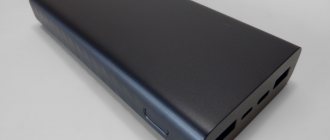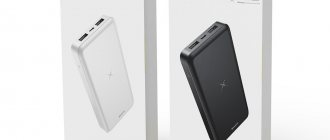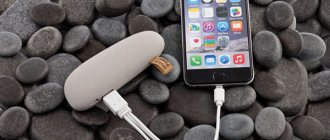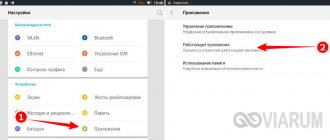When creating an external Xiaomi Power Bank for charging mobile devices, various protection methods are used to ensure safe operation of the device. During the transfer of electricity, the power bank guarantees safety during its overcharging, complete discharge, when operating at high temperatures, short circuits and other emergency situations. The safety of both the external battery and your mobile devices is ensured.
To obtain high capacitance characteristics, ATL/Lishen, as well as other lithium-ion polymer and TI batteries, are used. The product has high data on safety, element compatibility and operational efficiency.
Before you start using the battery, read the Xiaomi 10000 mah instructions in detail.
Attention! You cannot turn the device on or off by pressing the “Check Battery Level” button. The battery has a function that detects its charge level. Therefore, there is no need to press the “Control” key to check how much energy is left in the device. Before the battery is completely discharged, the indicator on it goes out within two minutes.
Design and equipment
The box of the device contains instructions for Xiaomi Power Bank 10000, a short USB-miscro USB cable, and the battery itself in a protective transport film. Powerbank can be charged from a PC or laptop, and for the outlet you will also need a power supply with a USB input. At the bottom end of the case the technical characteristics are indicated: volume 10,000 mah, and other information from the manufacturer. On the top there are indication, control elements, and ports.
| Characteristics of Power Bank 2 10000 | |
| Connecting the device | 1 USB input |
| Voltage, V | 5/9/12 |
| Current, A | 2,4 |
| Capacity | 10000 mah |
| Fast charging | Qualcomm Quick Charge 2.0 |
| Dimensions | 130x71x14.1 mm |
| Weight | 127 g |
Power button and LEDs
The instructions in Russian for Xiaomi Power Bank 2 indicate that the button is not intended to activate or turn off the equipment, but to check the charge level . The following commands are used for the button:
- Single click. Activates LEDs, by the number of which you can find out the approximate charge level.
- Press twice quickly. Necessary in order to activate low current charging (for transfer to other small-sized equipment).
Additional Information. When the charge is low, the Power Bank can still work, but the LEDs will stop lighting.
Information LEDs are arranged in a row, 4 pieces. By the number of active light elements, you can determine the level of charge or discharge.
Main characteristics
Despite the fact that this is a budget model, its characteristics are attractive. The manufacturer has added a number of useful features that are worth considering.
Battery capacity
Nominal capacity (as declared by the manufacturer) is 20,000 mAh. However, the actual amount of energy that can be obtained from any power bank at the output is usually about 1.5 times less. Part of it goes to the operation of the current converter, because the nominal voltage of external batteries is 3.6-3.8 V, while charging most gadgets requires a standard 5 V, and for fast charging even 9 or 12 V.
The actual capacity of the power bank is 12,000 mAh if charged in normal mode, and about 9,000-10,000 mAh if fast charging is used.
This is enough to, for example, fully charge an iPhone of any of the latest models (with a battery capacity of 2500-3000 mAh) 3 times. Or for 2 full charges of the Xiaomi Redmi Note 9 smartphone, the battery capacity of which is 5000 mAh.
Appearance, dimensions and weight
External battery Xiaomi Redmi Power bank Fast Charge 20000 mAh is available in two colors:
- white model PB200LZM;
- black model VXN4304GL.
The case is made of dense plastic. The surface is matte on the main parts and glossy on the side parts.
It’s difficult to call the device compact. The dimensions of the power bank are 15x7 cm, about the size of a palm. In addition, it is thick and weighty - almost 3 cm thick and weighs 445 g.
You won't be able to carry it in your pocket. It is most suitable for home use or travel: it is convenient to put it in a bag, backpack or suitcase.
Important! The button on the side panel of the bank is not intended to turn it on/off, but to check the charge level. When you press on the end, indicators light up, displaying how much energy is left in the battery.
Equipment
All you will find in the box besides the bank itself are instructions for its use. Neither a USB cable nor other accessories are included in the pb200lzm model.
Protection
The Xiaomi Redmi power bank uses a number of technologies that provide protection against:
- overheating;
- short circuit;
- overvoltage at the input and output;
- recharging and discharging.
Protection is provided both for the power supply itself and for the devices connected to it. You can, for example, charge your smartphone or the battery itself all night without fear for their safety.
Low current charging
A power bank may simply not sense the connection of a small device (for example, a Bluetooth headset or fitness bracelet), so a special low-current charging mode is provided for such gadgets.
You need to press the button on the portable battery twice, and the mode will be activated for two hours. Light indicators will help you understand that low-current charging has turned on. The lights will light up one after another, and not blink as during normal charging.
The mode is turned off by pressing the button once. But it is not necessary to do this - it deactivates itself either after two hours, or as soon as a more powerful device (for example, a smartphone) is connected to the power bank.
Pass-through charging
The power bank supports pass-through charging - its output ports do not turn off when it is plugged in and charging. You can charge both the power bank and the device connected to it at the same time. The output voltage will be limited to standard 5 V.
USB-A inputs and USB-C/micro-USB ports
The instructions for Xiaomi Power Bank 10000 indicate that ports of this type are used to transfer charge from an external battery to another gadget: smartphone, player, etc. To start the energy transfer process, it is enough to connect the devices with the supplied or similar cable. In older models from Xiaomi, there was only 1 USB-A connector in the case, in some versions there are 2 of them at once, which will allow you to charge several devices simultaneously.
These connectors, on the contrary, are necessary for charging the Power Bank itself. The old version used a micro-USB input, but Power Bank 2 already uses a double version, where in addition to it there is also a modern Type-C connector.
Additionally. According to the Xiaomi Power Bank 2 instructions, the device is equipped with protection against overcharging, overheating and short circuits.
Share your opinion or ask an expert a question
Ivan Korablev
Researcher, practitioner. Settings Expert. I study modern electronic devices. I try to keep up to date with all the new products.
or comment
Connectors and their maximum current
All connectors are located on the top end of the device:
- 2 USB ports per output;
- micro-USB port;
- USB Type-C.
USB output ports are designed for charging devices, the maximum power of each is 18 W. You can charge two devices at the same time, for example, two smartphones or a smartphone and a tablet.
Both the micro USB connector and USB-C work as input only. They are designed to charge the battery itself. You can use any of them, whichever is more convenient.
The built-in smart charge controller is compatible with most smartphones, tablets and other modern devices. External battery supports:
- output 5 V.1/2.4 A, 9 V/2 A, 12 V/1.5 A;
- input: 5 V/2.1 A, 9 V/2.1 A, 12 V/1.5 A.
Important! In this model, the USB-C connector does not work as an output - only as an input, so Power Delivery fast charging technology is not supported.
Charging process + indication
To charge the Power Bank, you need to connect it to a computer or a power outlet via a power supply using a micro-USB or USB-C port. Find out more about how to charge a Power Bank correctly and not damage the device. After connecting, the charging process of Xiaomi Power Bank 2 10000 mah will begin, and the instructions in Russian indicate the degrees:
- From 0 to 25%. At this level, only one LED will flicker, the rest remain in sleep mode.
- From 25 to 50%. The first LED will glow continuously, the second will flicker, and the others will be off.
- From 50 to 75%. Two LEDs are on, one is flickering, one is off.
- From 75 to 100%. Three LEDs are on, one is flickering.
- The charging process is complete. All 4 LEDs light up.
- An error has occurred. All 4 light bulbs.
The 5000 or 20800 mah model also has 4 LEDs; they are responsible for the percentage of the battery, but have their own capacity.
Attention
• When using for the first time, you must fully charge the Power Bank. • When using the product, turn on the screen of the digital device, check whether the charging indication is correct to ensure the correct operation of this device. • When receiving and supplying electricity, you must select the correct cable yourself. • If the capacity indicator goes out completely while charging digital devices, the battery needs charging. • When connecting the battery to digital devices, digital devices use electricity first. • After digital devices are fully charged, be sure to disconnect the cable in a timely manner to prevent malfunctions. • If, due to a short circuit or other reasons, the product has entered a safe mode (the LED near the power button does not light), the device must be connected to the network to return to normal operation.
Charge transfer
The instructions in Russian for Xiaomi Power Bank 2 say that the LEDs can also determine the degree of charge transfer. To do this, you need to insert a cable into the USB-A input of the external battery, and connect the other end to third-party equipment (for example, a smartphone).
Indication symbols:
- 0%. If Mi Power Bank is low, all lights are off.
- From 0 to 25%. Only one LED flickers.
- From 25 to 25%. Two lights flicker.
- From 50 to 75%. Three LEDs flash.
- From 75 to 100%. All the lights are flickering.
Warnings
The Xiaomi Power Bank 10000 has instructions in Russian, in which the “warnings” section is extremely important. It describes in detail what can harm the device and disable it. Also, some actions can be dangerous for the person himself, so you should strictly adhere to the rules:
- The instructions for the Xiaomi Power Bank 1000 say that the product is not a toy. It must be stored out of the reach of children. Also, do not allow children or pets to play with equipment.
- Checking the quality of the charger. It is important that the charger is suitable for the mains voltage and the battery. Otherwise, there is a risk of electric shock or damage to the battery.
- Careful use. It is important that the Power Bank is not exposed to vibrations, shocks, or powerful pressure . All this can lead to a short circuit or damage to the batteries.
- Water protection. The external battery should not come into contact with water, because it is not waterproof and water ingress can cause damage.
- The manual states that if the batteries are swollen, deformed, or show unstable operation with reduced capacity, then the device cannot be used. You can’t throw it away either; you need to hand it over for recycling.
- Ensuring the proper level of heat dissipation. During the charging process, it is important that the devices can freely exhaust air. If the Power Bank and phone are in your pocket, under your pillow, or in your bag, then the devices may overheat.
- Do not disassemble the Power Bank yourself , and it should also be kept away from batteries, stoves, fire and other heat sources. Operating the device at temperatures above 60 °C is prohibited.
- Do not leave the external battery in direct sunlight . He should always be in the shade.
There is a lithium polymer battery inside the device body. It is strictly forbidden to open it, heat it, or expose it to other actions; this is extremely dangerous.
Precautionary measures
Regardless of the capacity, both 10,000 and 20,000 mah Power Banks have their own precautions:
- Before using the device for the first time after unpacking, it must be fully charged to 100%.
- For high-quality charging you need appropriate power cables and a unit. The instructions indicate that it is better to use branded chargers from Xiaomi.
- Do not leave an external battery charging unattended. Before leaving the house, it must be disconnected from the power supply.
- When the indicators indicate that the charging process is complete, you need to disconnect the device from the network to avoid damage.
- When the Power Bank enters protection mode, the indicators do not light up when the button is pressed. To activate the device, you need to connect an external gadget.
The manufacturer recommends that during constant use, try to keep the charge at 25-50% (two LEDs) and store it in a cool, dry place. But a constant full charge or discharge can harm the operation of the device.
Enabling low current charging mode
For the external battery Xiaomi Mi Power Bank, the instructions advise using different modes depending on the characteristics of the second device. So, for small gadgets like a fitness bracelet or smart watch, a high load is not needed; the external battery may simply not recognize the device and turn off. In modern models, to avoid such problems, there is a special charging mode at low currents. We have made an interesting selection for you - the 15 best Power Banks for smartphones and tablets this year.
To activate it:
- You need to connect the Power Bank to the device being charged via a cable.
- Press the external battery button twice quickly.
- Activation of the mode will be indicated by alternating blinking of the LEDs.
In low current charging mode, the device will work for 2 hours, after which it will automatically turn off. If you need to finish this process as soon as possible, then just press the Power Bank button once.
Experience of use
A battery of this power should last a long time. It was experimentally determined that the full charging capacity is enough for:
| Device | Number of charges, times | Charge level on the device when power is connected, % | Charging time |
| Google Nexus 7 (2013) LTE (Asus) | 3.5 | From 14% to 100% | 1.2 hours |
| Google Nexus 5 (LG) | 6 | From 14% to 100% | 1 hour |
| Apple iPhone 5S | 6.5 | From 20% to 100% | 55 minutes |
| Apple iPad Mini Retina | 2 | From 20% to 100% | 1.1 hour |
| Canon EOS 60D | 6 | From 5% to 100% | 1.1 hour |
How to use fast charging mode
The second generation external batteries from Xiaomi are equipped with the Quick Charge function, in Russian it sounds like “Fast charging”. It allows the Power Bank to receive a charge faster, and it can also give it away faster. To activate the mode, you don’t need to press or configure anything; the device itself recognizes the fast charging mode, but two points are important for this:
- Using a special cable. USB cables that support fast charging are marked accordingly.
- The device receiving the charge must support the technology. For example, the Redmi Note 9 Pro phone supports this function, and some older models will charge as usual.
How to distinguish the original Power Bank
External batteries from Xiaomi are very popular, and there are many fakes on the market. There are several characteristics that indicate the originality of a product:
- There is a sticker on the box with the manufacturer's code. You can use it to check its originality.
- The Xiaomi Power Bank 10000 Pro kit includes instructions in Russian.
- Includes a branded USB cable with a high-quality plug.
- If you loop the cord (insert the input and output into an external battery), the protection system in the original will work.
Review of external batteries Xiaomi Mi Power Bank Pro 10000 and Mi Power Bank 5000
Both models under consideration from the Chinese manufacturer Xiaomi , which is very popular and even fashionable nowadays, do not belong to the “hot” new products, however, among the considerable number of external batteries (power banks) that we have visited, we have not yet encountered samples of this brand, so we started working with them with considerable interest.
Mi Power Bank Pro 10000
Information support, characteristics, equipment
Unfortunately, at the time of testing there was no description of the model in the Russian-language section of the company’s website, so we used information from the global website.
True, there is a slightly different model index - PLM01ZM, and we got PLM03ZM, but perhaps the difference is only in the orientation towards certain regional markets, which is hinted at by the following fact: the instructions in the copy we received were in Chinese, as were the inscriptions on the packaging.
You can also visit the official Xiaomi online store, where there is a fairly complete set of information in Russian, and you can also download Russian-language instructions (the translation is not perfect, but quite decent). True, such an index is not indicated there at all.
There are slight discrepancies in the information provided in these two sources and on the packaging, but they do not relate to the significant features of the model.
The packaging box is designed without any frills, but a “tax stamp” is glued to it: if you rub it with a coin or a fingernail in a gray square, you will see a 20-digit authentication code, by which you can check the authenticity of the product on the company’s official website. What to do if there is no confirmation is a separate question.
| Battery | lithium polymer 3.85 V, 10000 mAh (38.5 Wh) |
| Input voltage | 5/9/12 V |
| Input current | 5/9 V - 2 A, 12 V - 1.5 A |
| Output voltage | 5/9/12 V |
| Output current | 5/9 V - 2 A, 12 V - 1.5 A |
| Charging temperature | 0-45 °C |
| Discharge temperature | −20 °C to +60 °C |
| Charging time | 3.5 h (18 W charger) / 5.5 h (10 W charger) |
| Dimensions | 128.5×75×12.6 mm |
| Weight: external battery kit in package | 223 g 265 g (measured by us) |
| average price | find out prices |
| Retail offers | find out the price |
| Description on the manufacturer's website | mi.com |
We have already said more than once that the off-system unit “amp-hour” can often be misleading, especially when compared: the capacity in ampere-hours is the same for a tiny power bank battery and a hundred times larger and heavier UPS battery. And this is not a matter of technology, it’s just that in relation to electric batteries and batteries it is better to talk about the energy they store in watt-hours, which also takes into account the voltage they provide.
In this case, two energy values are given on the packaging and on the case: for the lithium-polymer battery itself 38.5 Wh and reduced to a 5-volt output, which is used by the connected loads, but again using an off-system unit: “7100mAh 5.0V". In terms of calculation, this gives an energy of 35.5 Wh - less than that of a battery, because voltage conversion cannot occur without losses, which in this case are not too large: the efficiency is 92%, in the descriptions a close value of 93% is found , and we will see what actually happens during testing.
The power bank claims to have protection against high voltage and overload (input and output), short circuit, overcharge and deep discharge. The use of a battery with a positive temperature coefficient (battery PTC) is also noted, and here it must be clarified: this is a set of technological measures aimed at producing lithium-ion battery cells with increased safety when operating in conditions other than normal. Probably, it is the presence of PTC that explains such wide temperature ranges of charge and especially discharge declared for this model.
Appearance, operating features
The power bank is made in a flat dark gray aluminum case with lighter plastic caps on the ends; no other colors are currently offered. True, in the “Gallery” of the official online store two color options are mentioned, but apart from the designations (“grey 3” and “grey 4”), we did not find any difference in the photographs provided.
The thickness of the walls of the case is about 0.5 mm - it is impossible to measure more precisely without opening it, and no one gave us sanctions for such an action. The rigidity is quite high, and the resistance to mechanical stress is clearly higher than that of plastic cases.
The materials available on the English-language resource speak of double anodizing, which can be considered a clear hint at the special durability of the coating. In addition, it mentions “CNC edge” (or “CNC-finished edges”); Perhaps the English-speaking reader will understand this abbreviation immediately, but we will explain: this means that the edges of the aluminum part of the body are processed on a CNC machine, and indeed, they have small neat chamfers, polished to a shine, which are absent from the next (cheaper) participant review.
The thickness and other dimensions roughly correspond to those of a modern smartphone, the screen diagonal of which is about 5 inches, that is, holding a “sandwich” of these two gadgets connected by a charging cable with one hand will be quite convenient. But we must take into account that one device may well scratch another, and it is better to equip one of them (or both) with a case, fortunately for the Mi Power Bank Pro 10000 such accessories are quite accessible, and in a wide range.
The cable is the only thing included. Its length is small, just under 20 cm from connector to connector, and in the aforementioned “sandwich” it will not be a very disturbing part. Another thing is that for other ways of mutual placement of a mobile device and a battery (for example, the first in the hand, the second in the chest pocket), as well as in some cases of connecting to a charger, such a cable may be too short.
At one end of the case there are only inscriptions, including those explaining the main parameters, and the connectors, along with controls and displays, are concentrated on the opposite.
There are two connectors: USB A(f) output and Type-C, used to recharge the power bank’s own battery. For universal connections, the supplied cable has a completely normal USB A(m) connector at one end, and a Micro-USB connector at the other end plus an adapter to Type-C, connected by a flexible leash that will prevent the adapter from getting lost.
On the one hand, it is very convenient, but on the other hand, you will have to carry this cable with you all the time or take care of purchasing such accessories in stock: there is not yet an abundance of cables with Type-C either in household supplies or in offices. In addition, you need to be careful: the connector and adapter connected together create a double lever compared to a single connector, that is, it will be easier to pull them out of the input port by accidental and careless action (or even break something).
By the way, some descriptions talk about a flat USB-Micro-USB cable and a freely detachable adapter to Type-C. We received a round cable (it is a little stiff) and with an adapter on a leash.
The presence of only one output connector in an external battery with such an impressive capacity can only be explained by the desire of the developers to make the device as compact as possible. You can also look from a purely practical point of view: do you often need to recharge two gadgets at once when you are away from outlets? If yes, and certainly at the same time, and you can’t wait, then, obviously, this product from Xiaomi is not for you.
Another question arises: why is the Type-C connector used specifically as an input? It is reliable and convenient (because it is symmetrical, that is, it does not need to be oriented in a certain way), but the owner will connect loads to the power bank more often than the external battery itself to the charger. It is also designed for very significant currents by the standards of USB connections, and the speed of charge recovery in the connected gadget is a higher priority compared to charging the battery of a power bank.
Another thing is that the fleet of mobile devices not only equipped with a USB Type-C connector, but also capable of using most of its capabilities is still small, but this is only a matter of time, and not the most distant one. Therefore, it would be more logical to assign USB A(f) as an input, and Type-C as an output, and even better, make both connectors Type-C - perhaps then a third one of the same type would fit.
In general, the Mi Power Bank Pro 10000 model turned out to be very compact and elegant, but still a little controversial.
Other organs include an indicator with four white LEDs and a button. If the indicator functions in a completely normal way (with one exception, which is discussed below), then the purpose of the button is somewhat different from what is usual in other models.
So, usually the output (or outputs) of a power bank turns off after a short time when there is no load, and it can only be reactivated by pressing a button. Of course, such a mechanism must have a certain threshold, below which the load is considered absent. But for a number of gadgets like Bluetooth headsets, the normal charge current is very small, and therefore it may well be below this threshold, and you simply won’t be able to charge them.
And in this model there is not only auto-detection of the presence of a load (we connect the device - voltage is supplied to it without pressing a button), but it also provides for working with extremely low output currents: you need to press the button twice, and then the output will not turn off for two hours. True, the Russian-language instructions we downloaded do not say this.
Otherwise, the button works the same as in other external batteries: pressing it once will allow you to check the remaining charge by the number of indicator LEDs that light up at the same time, and in some cases also reset the emergency state after the protection has tripped. If this does not help, then you can try a short-term connection to the charger - we encountered something similar when testing other power banks.
Testing
Charge
The charger was connected to the charger using the supplied cable, during the process the LEDs flashed evenly, their number allows us to judge the charge level.
When connected to a conventional charger with a current limit of 2.1 A, the consumption was initially 1.0 A, and could increase to 1.1 A in the process; if you turn it on for additional charging when the discharge is incomplete, the current can reach 1.15-1.17 A, but for a short time - then it drops again to 1 A.
Charging in this mode takes a long time: 8.5-9 hours, and only after about an hour the current begins to decrease. The body of the power bank heats up very little.
When all four LEDs light up, the input current is not zero - it remains at 50-70 mA for a very long time. Of course, we didn’t wait for days for the input current to zero, but after a few hours this didn’t happen. It’s hard to say how this not too large, but noticeable current is consumed, it’s clearly not to power four tiny LEDs; one might assume that this is a maintenance charge, but for lithium-ion batteries this is not usually practiced in constant mode.
Using a charger that supports Smart Charge modes gives a more pleasant picture: the initial current is 1.6 A, it changes a little during the process, but for a long time it is in the range of 1.4-1.6 A; heating is observed, but weak - by 6-8 degrees relative to the room temperature. A noticeable decrease in current began only after 6 hours, and the average charging time was 7 hours 15 minutes. Less than from a regular source, but still a lot.
We also tried charging from a source that supports Quick Charge technology (QC 2.0/3.0). When an external battery was connected, its output switched to 12-volt mode, the current remained at 1.5-1.6 A for a long time, and after 1 hour 45 minutes it began to decrease - at first little by little, after 2.5 hours (from the start of charging) at a faster pace. The average time was 3 hours 30 minutes, that is, the charge was restored two and a half times faster!
After an hour and a half, the heating reached 11-12 degrees relative to the initial temperature, and did not increase further.
In the last two cases, upon completion, the current was reset to zero.
Discharge
When discharged, the indicators do not light up constantly, like most other external batteries, but flash at long intervals. The number of LEDs that light up indicates the remaining charge - everything is quite normal here.
Voltage at no load or at low output currents 5.1 V.
Measurement data for normal mode is shown in the table.
| Current | Output voltage | Time until shutdown | Energy | Efficiency | ||
| at first | in progress | before shutdown | ||||
| 0.5 A | 5.1 V | unchanged until shutdown | 5.1 V | 14 hours 50 minutes | 37.8 Wh | 98% |
| 1.0 A | 5.0 V | 5.0 V | 7 hours 31 minutes | 37.6 Wh | 98% | |
| 1.5 A | 4 hours 59 minutes | 37.5 Wh | 97% | |||
| 2.1 A | 4.9 V | 4.9 V | 3 hours 30 minutes | 36.1 Wh | 94% | |
| 2.4 A | 3 hours 02 minutes | 35.7 Wh | 93% | |||
| 2.7 A | 2 hours 38 minutes | 34.7 Wh | 90% | |||
| 2.9 A | protection after 7 minutes | |||||
| 3.0 A | 4.9 V | protection after 8 seconds | ||||
In our reviews of power banks, we calculate efficiency as the ratio of the data obtained for the energy supplied to the load to the declared value. We introduced this conditional concept for the convenience of comparing models of external batteries that we have visited with different declared capacities, and usually it is given only for the battery, and so that the comparison is correct both with other models and with Quick Charge modes for Mi Power Bank Pro 10000 ( information about the conversion efficiency for them is not provided in official sources), the last column of the table also used data from a lithium-polymer battery, that is, 38.5 Wh.
The obtained values can be considered an excellent result, in fact a record, especially because they change little over a wide range of loads, including those significantly exceeding the stated maximum. In addition, in all measurements the output voltage is very stable and differs little from the standard USB five volts.
The protection is triggered when overloads are close to one and a half times, that is, the overload capacity in the long term is at least 35%, and within a few minutes it can be at the level of 45%.
We also tested Quick Charge modes, which we set using a special trigger. For QC 2.0 you can choose 5, 9 and 12 volts, for QC 3.0 the maximum voltage is 12.4 V (remember: in QC 3.0 changes are made in steps of 0.2 V).
Two measurements were made in QC 2.0 with the maximum declared currents for voltages of 9 V and 12 V.
| Current | Output voltage (QC 2.0, 9 and 12 volt modes) | Time until shutdown | Energy | Efficiency | ||
| at first | in progress | before shutdown | ||||
| 2.0 A | 9.0 V | gradually increases by a small amount | 9.2 V | 1 hour 49 minutes | 33.0 Wh | 86% |
| 1.5 A | 12.2 V | 12.5 V | 1 hour 24 minutes | 25.8 Wh | 67% | |
As you can see, conversion in QC modes occurs with significantly greater losses, and if for the 9-volt mode the efficiency remains relatively high, then for the 12-volt mode it is already at a very average level. That is, for accelerating the charging of a connected gadget, you have to pay for the inefficient use of power bank battery energy.
Naturally, long-term operation under a significant load cannot be done without heating. At first, the part closest to the connectors heats up more, but, thanks to the good thermal conductivity of the aluminum case, the temperature soon becomes almost the same over the entire surface.
The maximum we recorded was when the output was operating in 12-volt mode at a load of 1.5 A: by the time it was turned off, the heating was 19-20 degrees relative to the room temperature, that is, the power bank became very, very warm.
We also tried working with very light loads. Pressing the button once connects the output, but for a short time: about 25 seconds for currents of 20 mA or less; as the load increases to 70-80 mA, the voltage can last for 2.5-3 minutes, but a shutdown will still occur.
If you press the button twice in a row with a minimum interval, the output is connected even in the absence of load. A sign of transition to this mode is alternate short-term blinking of the LEDs. We did not check whether this regime would last the promised two hours - we only had enough patience for 30 minutes. You can switch off early by pressing the button once.
Mi Power Bank 5000
Information also had to be obtained from the global website, since this model was not available in the Russian-language section of the manufacturer’s website at the time of writing the review. The model index NDY-02-AM indicated there coincided with that shown on the case and packaging.
Characteristics, appearance, equipment
The declared parameter values are given in the table.
| Battery | lithium-ion 3.7 V 5000 mAh (18.5 Wh) |
| Input voltage | 5 V |
| Input current | 2 A |
| Output voltage | 5.1 V |
| Output current | 2.1 A |
| Charging temperature | 0-45 °C |
| Discharge temperature | from −20 to +60 °C |
| Charging time | 3.5 h (charger 5 V, 2 A) / 5.5 h (charger 5 V, 1 A) |
| Dimensions | 125×69×9.9 mm |
| Weight: external battery kit in package | 156 g 195 g (measured by us) |
| average price | find out prices |
| Retail offers | find out the price |
| Description on the manufacturer's website | mi.com |
Both models are very similar both in appearance and design. Only the aluminum body of the Mi Power Bank 5000 is lighter - not gray, but rather silver, and the plastic on the end caps is milky white. There are no beautiful chamfers on the edges, but it looks like the aluminum layer itself is a little thicker - we cannot say this definitely without accurate measurements, and we were not allowed to open this model either.
At one end there is the same set of organs: two connectors, four white indicators and one button. Only this time the input is not Type-C, but Micro-USB, like the vast majority of similar products.
Both models are similar in size, the thickness of the Mi Power Bank 5000 is 20% smaller - it seems significant, but in reality these almost three millimeters of difference are noticeable mainly in direct comparison. But the youngest is almost a third lighter in weight, and you can feel it even with your hand, without any measurements.
The design of the packaging is even simpler: if the Mi Power Bank Pro 10000 had at least an image of the power bank, then for this model the front side of the box contains only the company logo (the authentication sticker is on the other side). But the inscriptions both on the packaging and on the “blind” end of the case were in English, and we received the manual in Russian.
Once again, only a cable is included - this time a flat one, with USB A(m) and Micro-USB connectors. Length 17 cm, no adapters.
The presence of protection against overload and excess voltage, short circuit, overcharge and deep discharge is declared. The descriptions talk about auto-detection of the presence of a load, that is, the button is also used not to connect an output, but only to check the charge level, but this time there are no instructions about working with extremely small loads - you will have to check in practice how things are.
The model also uses a positive temperature coefficient battery, so the operating temperature range is equally wide.
The “reduced to five volts” capacity in milliamp-hours is not indicated in this case, but it can be easily calculated by yourself using the algorithm we presented above. Although the specification does not contain a line for conversion efficiency, a value of 93% is found in the descriptions.
Testing
Charge
We tried charging the power bank not only from different chargers, but also using different cables, fortunately we didn’t have to search for them for a long time.
We started with the complete one, connecting it to a charger with support for Smart Charge (PowerIQ) and a maximum output current significantly exceeding 2 A (in reality, and not just according to the indicated parameters). The initial charge current was a pleasant surprise: 1.7-1.75 A, and soon even increased to 1.85-1.9 A, and began to decrease after two and a quarter hours. The total time was 3 hours 15 minutes, that is, it fully corresponds to the declared value. At the same time, the case warmed up a little, by 9-10 degrees relative to the initial state.
But the point is not at all in Smart Charge, but in the cable: if you connect a standard cable to the most ordinary adapter with an “honest” maximum of 2.1 A, then the situation changes little: the current starts at 1.7 A and remains at the level for a long time 1.6-1.75 A, a decrease is observed after two and a half hours, and the total time is 3 hours 45 minutes.
If the cable is replaced with another one, and not quite a “left one”, even with a designated cross-section of 28AWG (0.081 mm²), and not an exorbitant length - 95 cm, then the current under the same conditions will not exceed 0.8-0.85 A , starting to decline in the last 50-55 minutes. The total charging time was 5 hours 40 minutes.
With a third cable, a meter long and without any “identification marks”, from a conventional 2.1 A charger the current did not exceed 0.45-0.5 A, and therefore charge restoration took 9 hours 45 minutes, the current and In this case, it began to decline in the last hour.
Of course, the values indicated for the charging time are approximate, because the preliminary discharge was carried out with different currents to fill out the table below, and low currents discharge the battery more strongly. However, this may explain the difference of tens of minutes, but not several hours.
There are no miracles here. We measured the voltage drop on these cables: for the first (standard) at a current of 1.0 A it was slightly more than 0.1 V, for the second it was 0.45 V, which agrees well with the normalized resistance for 28AWG of 0.213 Ohm/m (v the cable has a pair of wires almost a meter long), and we can assume that the cross-section of the wires of the standard cable is the same, it’s just about five times shorter. On the third, almost 0.8 V dropped - the same amount less compared to the nominal five volts would have been supplied to the input of the power bank at this current; It’s surprising that with such a cable the device was charged at all.
The built-in indicator is quite accurate: as soon as the last LED lights up continuously, the current becomes zero.
Discharge
The behavior of the indicators is the same as that of the Mi Power Bank Pro 10000: not constantly lit, but briefly blinking.
Voltage at no load or at low output currents 5.1 V.
The measurement data is given in the table.
| Current | Output voltage | Time until shutdown | Energy | Efficiency | ||
| at first | in progress | before shutdown | ||||
| 0.5 A | 5.0 V | stable, but 20 minutes before shutdown it drops abruptly by 0.5 V | 4.5 V | 7 hours 04 minutes | 17.5 Wh | 95% |
| 1.0 A | 5.0 V | unchanged until shutdown | 5.0 V | 3 hours 23 minutes | 17.0 Wh | 92% |
| 1.5 A | 2 hours 07 minutes | 15.9 Wh | 86% | |||
| 2.1 A | 4.9 V | 4.9 V | 1 hour 27 minutes | 14.9 Wh | 80% | |
| 2.4 A | 1 hour 12 minutes | 14.2 Wh | 77% | |||
| 2.5 A | the output is not connected, protection is triggered | |||||
When calculating the efficiency, we took the value declared for the energy of the built-in battery to be 18.5 Wh. The results were quite good, especially at currents up to 1 A, but overall not as outstanding as the previous model. However, here too it should be noted the high stability of the output voltage, despite the annoying drop at the end of the discharge with a current of 0.5 A: if you count, it lasted less than 5% of the total time.
The overload capacity is also quite good: the power bank confidently operates with an overload of up to 15% without deteriorating the output parameters. True, the output at currents above the stated maximum may not always be automatically connected; sometimes you have to “spur” the device with a button. Starting from 2.5 amperes, it is not possible to make the device work at all.
At low and medium currents, the heating of the case is insignificant; at 2.1 A, in an hour and a half it heated up by 13-14 degrees compared to the initial state, then the temperature practically did not change. The same heating occurred just before the shutdown at a current of 2.4 A.
The function of long-term connection of an output by double pressing a button is not implemented in this model, but otherwise a power bank with light loads behaves in the same way as the product described first: a single press will turn on the output voltage, but only for a while. The only thing that differs is the proportion between the load size and the time before turning off after pressing the button: at very low currents it takes 20 seconds, at 60-70 mA just over a minute, at 80-90 mA it already works for a very long time (waited 10 minutes, does not turn off).
Quick Charge support is not stated in the description, but we still spent a couple of minutes checking: the trigger we used could not enable either QC 2.0 or QC 3.0.
Bottom line
We reviewed two samples of Xiaomi , briefly the impressions are as follows.
Mi Power Bank Pro 10000 is a very stylish, compact model with excellent parameters (the results of our tests were sometimes even better than promised in the specifications), but a little contradictory. One of the contradictions, as often happens, is related to the advantages: the battery capacity is very large for such dimensions, and the maximum load current is also more than decent, but there is only one output connector - you cannot connect two gadgets at the same time. The purpose of the output connectors is also puzzling: it would be more logical to make Type-C the output connector and USB A(f) the input connector.
Mi Power Bank 5000 is smaller, simpler, but also cheaper. Although this is not outstanding in terms of properties, it is quite a good product that corresponds to the declared parameters.
It must be said that the list of power banks produced by the company is not limited to these two models, and will certainly be expanded in the future. We can hope that the rest of the brand’s external batteries are at least as good as the youngest of those reviewed.











